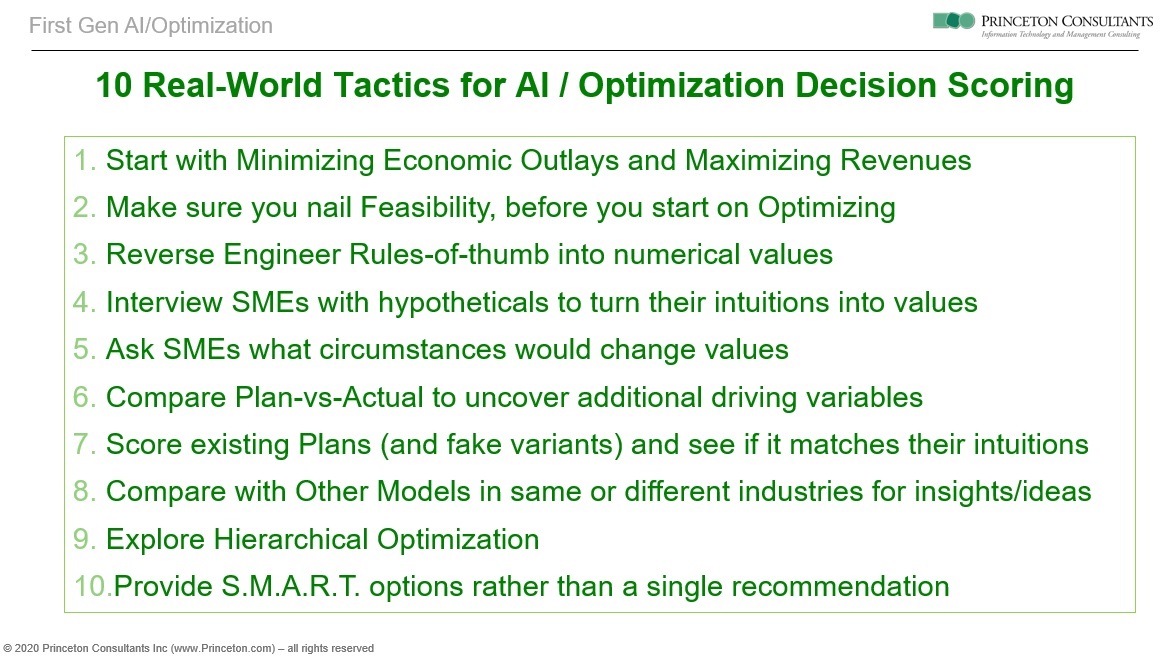Following is a lightly edited excerpt from Steve’s presentation for “New Frontiers of Analytics Practice” at the INFORMS Annual Meeting in November. For his introductory discussion of fuzzy objectives, see the previous post.

Following is a lightly edited excerpt from Steve’s presentation for “New Frontiers of Analytics Practice” at the INFORMS Annual Meeting in November. For his introductory discussion of fuzzy objectives, see the previous post.

Following is a lightly edited excerpt from Steve’s presentation for “New Frontiers of Analytics Practice” at the INFORMS Annual Meeting in November.
Princeton Consultants helps organizations move great insights into AI deployment. Our value proposition is that we deliver high speed and quality, and reduced risk. For the latter, we have developed a series of scoreable risk factors called the “Princeton 20.” For a typical first-generation AI optimization project, we work with management and tag different factors that should be addressed to make the project as successful and as low risk as possible.

Margaret Wright is a distinguished researcher in optimization, linear algebra, and scientific computing, currently the Silver Professor of Computer Science at the Courant Institute of Mathematical Sciences, New York University. She is best known for groundbreaking work on barrier methods and nonlinearly constrained optimization, and on optimization without derivatives. In 2019 she was awarded the John von Neumann prize for her contributions to the numerical solution of optimization problems.
I have known Margaret since I was a graduate student in the mid 1980’s at Stanford when she was a research professor in the university’s Systems Optimization Laboratory. In August 2019, I interviewed her for the INFORMS Oral Histories program (video and full transcript are found here).

Gurobi hosted a webinar by Irv and Rob to discuss innovative optimization work with Birchbox, the trailblazing e-commerce business. They were joined by Birchbox VP of Global Business Technology David Bendes, who leads subscription technology and operations, data and business intelligence, and platform product management, focusing on creating data‑driven experiences and the technologies that power them. We summarized the technical aspects of this work in a previous post; following are lightly edited excerpts from the webinar.

Steve is a frequent guest on Sirius XM’s Road Dog Trucking Radio, discussing a variety of tech-related topics with host Mark Willis and drivers nationwide. Following is a lightly edited excerpt of his June 30 appearance.
Mark: Some of the drivers over the the last few years have said they welcome new technology—bring it on. You know, optimization. They want to get the most bang for the buck, if you will, when it comes to the digitization of freight. Many have said they miss the old days—they miss the days of the paper logs, they miss the face‑to‑face conversations with the people at the docks and things like that. With Artificial Intelligence, it sounds like a lot of folks are getting on board but how do you convince the old school guys that may have to cross that bridge?

Soon there will be sports and entertainment returning to arenas and stadiums, hopefully with fans in attendance. As regulations are established and subsequently altered and as social distancing standards at large public events evolve, the managers of these venues will face understandably difficult challenges.
The main short-term problem is to determine where people can be seated in the venue while observing safe social distancing practices. One size can’t fit all: each venue has its own seating chart, season ticket holder population, and other important considerations.

As the COVID-19 pandemic continues to evolve under great levels of uncertainty, manufacturing executives are urgently formulating policies to keep their facilities operating while protecting workers from infection. These policies include macro issues, such as which workers are essential, down to micro policies such as how to best manage shared areas like hallways, break rooms and bathrooms. Without rigorous, quantitative tools and support of the new policies they are creating, executives are effectively flying blind. As evidence, in one European survey, about 70 percent of executives from Austria, Germany, and Switzerland said the pandemic is likely to accelerate the pace of their digital transformation.

Princeton Consultants recently conducted its annual survey, begun in 2016, of transportation executives about their views of disruptive technologies and the impact on business areas. CEO Steve Sashihara summarized the results on a conference call with Stifel Managing Director of Research David Ross. Following is a lightly edited excerpt.

On a March 27 conference call with Stifel Capital Markets and transportation executives nationwide, Steve summarized the results of the annual Princeton Consultants survey about tech disruption in freight transportation and logistics. This Freightwaves article summarized the survey and the findings. In the second half of the call (lightly edited excerpts below), Steve explained that in the Coronavirus environment, executives may benefit from optimization techniques to mitigate supply chain failures such as the “bullwhip effect.”

In a critical back-office operation, a broker-dealer firm must segregate a federally regulated amount of cash and securities in specially protected accounts on behalf of its clients to ensure that clients can withdraw the bulk of their holdings on demand, even if the firm becomes insolvent.